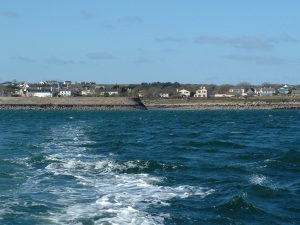I laid a new mooring in 2005. Starting from the seabed, the mooring consists of a cast concrete block with ships chain cast in situ connected by shackle to 4 metres of heavy chain, connected to 10 metres of nylon warp which ends in a soft eye, which holds the boat.
Over the winter with our boat on the hard, I thought I would inspect the lower down bits you seldom get to see.The results were very interesting.
The shackle connecting warp thimble to chain was on its last legs.

The corrosion has eaten away the pin to the extent that you can clearly see a gap in the threaded part of the pin. The warp we use is 25mm diameter. The pin of the shackle in the pic was 20mm originally. It has now corroded down to 16mm and the deformed severely corroded pin is probably around 12mm. The shackle body started off about 100mm in length, and is now down to 86 mm.

The action of the chain pull pull pulling on the shackle has caused severe wear on the round portion of the pin.
The chain itself was quite corroded and needed replacement – didn’t get a snap of that. Glad I investigated. I don’t think it would have lasted another season. To compare the before and after shackle size, I am posting a pic of the replacement shackle which to the best of my knowledge is very simiar to the corroded shackle above.

Another area of concern was where the mooring line went through the stem head anchor chain roller
Because the warp is somewhat narrower than the gap of the anchor-roller the sideways pull on the warp had caused considerable chafe here. At least this is visible from on deck and can be regularly inspected during the season.

I had tried to eliminate this with some soft pipe over the warp – this was pretty successful but a colleague who simply closed the gap with extensive use of hard wearing tape seemed to have avoided any chafe whatsoever.
It is the time of year to be checking this kind of thing.
I highlighted this issue on a thread on PBO forum and got some very interesting comments:
Some people have reverted to rope for mooring riser here with some success. You need a large diameter rope and the steel thimbles will still wear away. As will any shackles used. So yes even with the best heaviest gear a mooring needs to be inspected every year. In shallow water I check mine visually by diving every few weeks.




